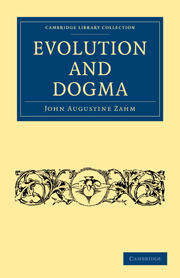Book contents
- Frontmatter
- PREFATORY NOTE
- Contents
- INTRODUCTION
- PART I EVOLUTION, PAST AND PRESENT
- CHAPTER I NATURE AND SCOPE OF EVOLUTION
- CHAPTER II EARLY EVOLUTIONARY VIEWS
- CHAPTER III FOSSILS AND GIANTS
- CHAPTER IV SPONTANEOUS GENERATION AND SCIENTIFIC DISCOVERY
- CHAPTER V FROM LORD BACON TO CHARLES DARWIN
- CHAPTER VI CONTROVERSY AND PROGRESS
- CHAPTER VII EVIDENCES OF EVOLUTION
- CHAPTER VIII OBJECTIONS AGAINST EVOLUTION
- PART II EVOLUTION AND DOGMA
- AUTHORS AND WORKS CITED IN “EVOLUTION AND DOGMA.”
- GENERAL INDEX
CHAPTER III - FOSSILS AND GIANTS
Published online by Cambridge University Press: 29 August 2010
- Frontmatter
- PREFATORY NOTE
- Contents
- INTRODUCTION
- PART I EVOLUTION, PAST AND PRESENT
- CHAPTER I NATURE AND SCOPE OF EVOLUTION
- CHAPTER II EARLY EVOLUTIONARY VIEWS
- CHAPTER III FOSSILS AND GIANTS
- CHAPTER IV SPONTANEOUS GENERATION AND SCIENTIFIC DISCOVERY
- CHAPTER V FROM LORD BACON TO CHARLES DARWIN
- CHAPTER VI CONTROVERSY AND PROGRESS
- CHAPTER VII EVIDENCES OF EVOLUTION
- CHAPTER VIII OBJECTIONS AGAINST EVOLUTION
- PART II EVOLUTION AND DOGMA
- AUTHORS AND WORKS CITED IN “EVOLUTION AND DOGMA.”
- GENERAL INDEX
Summary
Early Notions Regarding Fossils
IN the beginning of the sixteenth century geological phenomena began to attract more attention than they had hitherto received. Special interest was centered in fossils, which were so universally distributed over the earth's surface, and their study contributed materially towards placing the theory of Evolution on a firmer basis than it ever before possessed. Aristotle and other Greek writers had, indeed, made mention of them, but did not, as it appears, devote to them any particular study.
Theophrastus, a pupil of Aristotle, supposed them to be due to “a certain plastic virtue” of the earth, which possessed the power of fashioning inorganic matter into organic forms.
The distinguished painter, Leonardo da Vinci, one of the most gifted men that ever lived, was among the first to dispute the absurd theories which were currently accepted regarding the nature and origin of fossils. “They tell us,” he says, “that these shells were formed in the hills by the influence of the stars; but I ask, where in the hills are the stars now forming shells of distinct ages and species? And how can the stars explain the origin of gravel, occurring at different heights and composed of pebbles rounded as by the motion of running water; or in what manner can such a cause account for the petrification in the same places of various leaves, sea-weeds and marine crabs?”
- Type
- Chapter
- Information
- Evolution and Dogma , pp. 31 - 40Publisher: Cambridge University PressPrint publication year: 2009First published in: 1896



